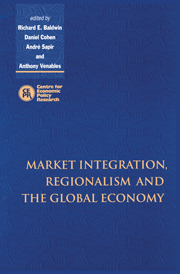Book contents
- Frontmatter
- Contents
- List of figures
- List of tables
- Preface
- Acknowledgements
- List of conference participants
- 1 Introduction
- PART ONE REGIONALISM AND THE GLOBAL ECONOMY
- 2 Regionalism vs. multilateralism
- Discussion
- 3 Preferential agreements and the multilateral trading system
- Discussion
- 4 Politics and trade policy
- Discussion
- 5 Globalisation and labour, or: if globalisation is a bowl of cherries, why are there so many glum faces around the table?
- Discussion
- 6 Openness and wage inequality in developing countries: the Latin American challenge to East Asian conventional wisdom
- Discussion
- PART TWO MARKET INTEGRATION AND REGIONALISM
- Index
5 - Globalisation and labour, or: if globalisation is a bowl of cherries, why are there so many glum faces around the table?
Published online by Cambridge University Press: 24 February 2010
- Frontmatter
- Contents
- List of figures
- List of tables
- Preface
- Acknowledgements
- List of conference participants
- 1 Introduction
- PART ONE REGIONALISM AND THE GLOBAL ECONOMY
- 2 Regionalism vs. multilateralism
- Discussion
- 3 Preferential agreements and the multilateral trading system
- Discussion
- 4 Politics and trade policy
- Discussion
- 5 Globalisation and labour, or: if globalisation is a bowl of cherries, why are there so many glum faces around the table?
- Discussion
- 6 Openness and wage inequality in developing countries: the Latin American challenge to East Asian conventional wisdom
- Discussion
- PART TWO MARKET INTEGRATION AND REGIONALISM
- Index
Summary
Introduction
The increasing pace of international economic integration, as a consequence of global convergence on liberal trade policies as well as advances in transportation and communication technologies, has opened an interesting chasm between economists and the common folk who often feel they bear the brunt of globalisation. Most economists tend to view expanding trade and foreign investment opportunities as inherently desirable, because they believe that these opportunities improve the efficiency with which market economies operate and enhance growth prospects. The troubled state of labour markets in advanced industrial economies, on the other hand, has led many influential groups in society – policy-makers, labour advocates, pundits in general – to link these ills directly to the process of globalisation. Intensified competition from lowwage countries, both as sources of imports and as hosts for foreign investors, is alleged by these groups to be largely responsible for the stagnation or decline of real wages of low-skilled workers in the Anglo- Saxon countries and for increasing unemployment in the continental European countries.
In absolving trade from any significant responsibility for these ills, many economists have taken a tack which sits uncomfortably with their faith in the benefits of free trade. The conclusion that trade with labourabundant countries would reduce real wages in rich countries – or increase unemployment if wages are artificially fixed – is one that has been a cornerstone of traditional trade theory. Indeed, in the standard factor-endowments model, it is precisely through changing the effective relative abundance of different factors of production that trade creates gains for all nations.
- Type
- Chapter
- Information
- Market Integration, Regionalism and the Global Economy , pp. 117 - 150Publisher: Cambridge University PressPrint publication year: 1999
- 11
- Cited by



